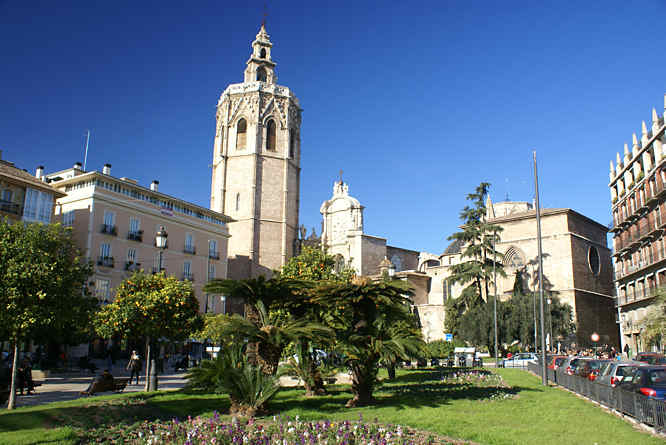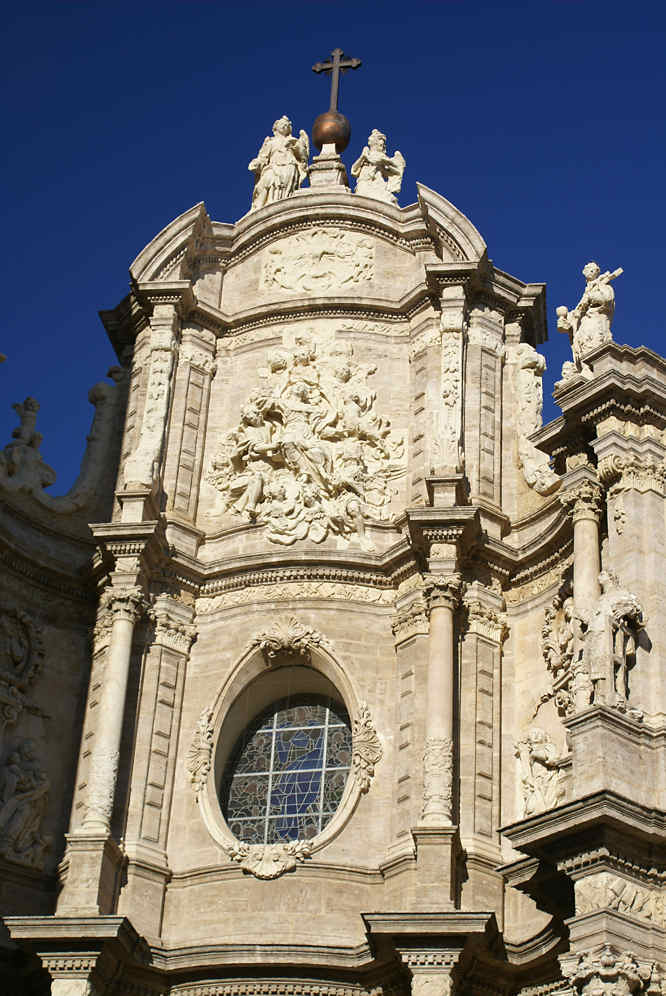Plaza de la Reina - The Queen's Square in Valencia
There is a pleasant green square behind Valencia Cathedral. There are lots of orange laden trees in the middle. It is surrounded by a variety of interesting eating establishments. This was my favourite Valencian Square.

Cerveceria 100 montaditos - Cheap Good Tapas Bar
This is a great new concept Bar. We had a lot of fun trying the different drinks and Spanish food. The prices are good. Find a table to sit at and take one of the long thin paper menus and pen. You write on the left side what you want to drink. On the right hand side of the menu you will see a long list of different tapas fillings. Just write down how many you want and hand it to the waitress. The wine, beer and food is good value for money compared with the rest of Valencia.
It is a fun way to order your food. The Tapas fillings comes in small begets that are cooked in ovens on the premises with a hand full of crisps on a dish. Ask for the English translation of the menu (pronounced - ingles menu per fa-vor?). The toilets are modern and clean. They are at the back of the bar.
If you need the toilet and you are near the Cathedral these are a good choice to use even if you are not eating. The place is normally busy so the staff will not notice you are not a customer. I really recommend this bar. It is a great fun place to eat and drink. Children are welcome too.

Valor Chocolate Cafe
On the east side of the square is the wonderful Valor Chocolate Cafe. It offers an extensive range of hot and cold chocolate drinks, cakes and deserts. The menu is in the form of a flip chart. They are on each table. There is an English translation on the menu but it is not immediately obvious.
Spanish Drinks
Horchata If the heat and thirst get you down, there's nothing better than an original milk like drink called Horchata to pick you up. For a mid-afternoon snack, order some fartons ,similar to long thin quasants, to dunk in this cool, refreshing drink. Horchata is made from 'chufa' (it is a root). It is sometimes called tiger nut but is like crushed almond. Arabs brought chufa from Egypt around 700 BC. Valencia horchata is different from the Mexican horchata which is made from rice. If you drive outside the city centre you may see small fields planted with what looks like dark green grass. That is Chufa being grown. Try Churros con chocolate (sweet dough strips that you dip in hot chocolate).
Orange juice is a popular drink in Valencia. The word 'naranja' means orange. The Muslim Arab Moors introduced them to Spain and started to cultivate them on the rich farm lands around Valencia. Valencia is known as orange country. Fresh juice is relative cheap and most of time served with some sugar because the juice can be really sharp.
Cafe de Valencia is something we had in the coffee house at the Mercado de colon.
Cafe fuerte , licor de naranja y limon - A strong coffee with orange and lemon liqueur. It is served in two different layers since the coffee and the liqueur don't mix very well. It is one of those taste you either like or hate
Agua de Valencia (Valencia Water alcoholic drink) is made from orange juice, champagne and vodka. The good pub areas are in the Malvarrosa, Canovas or the Barri del Carme. Start with some Agua de Valencia, but go easy at first if you want to last the whole night.
Valencia & Paella
Paella is big in Valencia. This is the city where paella was invented. The locals say that paella eaten out side the city is not authentic traditional paella. The dish was considered peasants food. It was normally made with a little bit of whatever was on hand or left over. Today, it is one of Spain's most popular dishes. Paella takes its name from the Valencian word for name of the dish in which it is cooked. 'La Paella' is a circular and shallow pan with two round handles and a flat base traditionally made of iron.
Rice was introduced to Spain by the Muslim Arab Moors as a commercial crop. It became part of the local traditional dishes. The farmers of Valencia would use the paella pan to cook rice with readily available ingredients from the countryside like tomatoes, Onions and Snails. On special occasions Rabbit or Duck might be included, and the better off could afford Chicken. Those that lived near the sea added fish and other seafood.
By the end of the nineteenth century 'paella valenciana' had become famous. Paella is really a Sunday dish eaten when the whole family is together. It is best cooked outside over an open wood fire and this is how it is often done. In Spain, grandmothers can still be found making it in the back garden for the family on a special occasion. In some restaurants the further you sit away from the bar the more expensive your meal will be. Sitting around a street table outside the cafe can be expensive. Check the menu for additional costs. Check your bill as service charges are normally included so you do not have to leave a tip
Travel books

